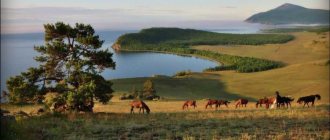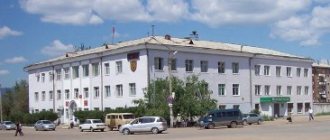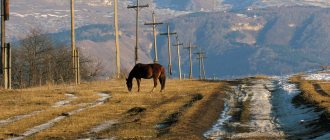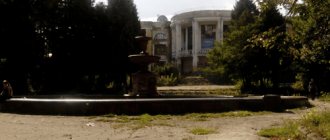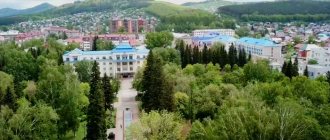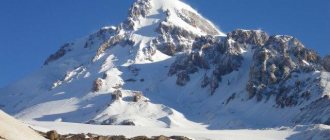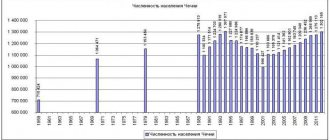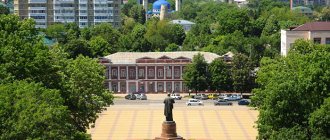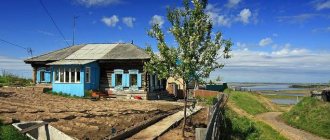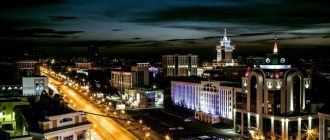Save it for yourselfPrint
In the southern part of Eastern Siberia, where the border of Russia and Mongolia passes, the Republic of Buryatia is located - an amazing region, amazing with its natural resources, diversity of traditions and cultures, and a bizarre mixture of Buddhism and shamanism.
Once these lands were part of the Great Mongol Empire, and after joining the Russian Empire, dissidents were exiled to Buryatia: Old Believers, led by the frantic Archpriest Avvakum, and later the noble Decembrists found refuge in these places.
The descendants of the “Semeyskie” (as the Old Believers are called in these places) have preserved their original dialect, traditions, beliefs and rituals to this day. Semey villages are easily recognizable by their special huts - tall, with windows decorated with bright carved frames, which are located at a height of 1.5-2 meters above the ground. Many houses have preserved traditional household utensils and colorful family outfits. By the way, the original Semeisk culture is included by UNESCO in the list of masterpieces of the intangible heritage of humanity.
Urban settlements
- Selenginsk
Population 13,500 (2020).
- Onokhoy
Population 10,837 (2020).
- Taximo
Population 7,691 (2020).
- Ust-Barguzin
Population 6,955 (2020).
- Kamensk
Population 6,607 (2020).
- Zaigraevo
Population 5,138 (2020).
- Nizhneangarsk
Population 4,209 (2020).
- New Uoyan
Population 3,025 (2020).
- Headphones
Population 2,821 (2020).
- Kichera
Population 946 people (2020).
- Severomuisk
Population 683 people (2020).
- Yanchukan
Population 259 people (2020).
Unique places
There are many special places in Buryatia that help in solving certain problems. For example, many athletes come to pray at Omulevka, a sacred place known as “Bogatyr. Couples desperate to have children come for help to the cave of the Mother’s Womb or to the Face of Yanzhima, a miraculous image of the Goddess of Fertility, which mysteriously appeared on a large boulder located in the Barguzin taiga.
Some unique places are accessible only to men. For example, women are prohibited from visiting the sacred mountain Bayan Tugad and Barkhan-uula. This is the place where, according to Buryat legends, the earthly and divine worlds converge.
Visiting some sacred places is considered a kind of “exam”, a test of the spiritual qualities of pilgrims. So, on Alkhanai there is the Gorge of Sinners.
It is believed that virtuous people pass this place without difficulty, but sinners, who are hampered by the burden of sins, get stuck and have difficulty moving along the gorge. Another similar place is located on a mountain near the Khalyutinsky springs. According to legend, the Tree of Wishes grows on the top of the mountain. But there is no single path leading to it - everyone must find the way on their own. Moreover, the more good deeds a person has done, the easier it is for him to find the treasured tree, and evil and cruel people will not find it at all.
see also
- Buryatia
- Symbols and sights of Buryatia
- Cities of Russia
| [ + ] Cities by regions of Russia | |
| Cities of the North-West (NWFD) | St. Petersburg (and its cities) • Leningrad region (historical Staraya Ladoga) • Arkhangelsk region • Vologda region • Kaliningrad region • Karelia • Komi • Murmansk region • Nenets Autonomous Okrug • Pskov region |
| Cities of the Volga region (Volga Federal District) | Bashkortostan • Volgograd region • Kalmykia • Kirov region • Mari El • Mordovia • Nizhny Novgorod region • Orenburg region • Penza region • Perm region • Samara region • Saratov region • Tatarstan • Udmurtia • Ulyanovsk region • Chuvashia |
| Cities of Southern Russia (SFD) | Sevastopol (including Inkerman) • Republic of Crimea • Adygea • Astrakhan region • Krasnodar region • Rostov region |
| Cities of the North Caucasus (NCFD) | Dagestan • Ingushetia • Kabardino-Balkaria • Karachay-Cherkessia • North Ossetia - Alania • Stavropol Territory • Chechen Republic |
| Cities of the Urals (Ural Federal District) | Kurgan region • Sverdlovsk region • Tyumen region • Khanty-Mansi Autonomous Okrug - Yugra • Chelyabinsk region • Yamalo-Nenets Autonomous Okrug |
| Cities of Siberia (Siberian Federal District) | Altai Republic • Altai Territory • Irkutsk Region • Kemerovo Region • Krasnoyarsk Region • Novgorod Region • Novosibirsk Region • Omsk Region • Tomsk Region • Tyva • Khakassia |
| Cities of the Far East (FEFD) | Amur Region • Buryatia • Jewish Autonomous Region • Trans-Baikal Territory • Kamchatka Territory • Magadan Region • Primorsky Territory • Sakha (Yakutia) • Sakhalin Region • Khabarovsk Territory • Chukotka Autonomous Region |
| see also | Cities of the DPR, LPR, Transnistria, South Ossetia • Regions of Russia • Cities of Russia |
General information about the Republic of Buryatia
Distinctive features . Buryatia is located on the eastern coast of Lake Baikal - the deepest and cleanest lake on Earth. 20% of the world's fresh water reserves are concentrated here. Baikal is surrounded on all sides by mountains, and its level is 445 m above sea level.
Lake Baikal is a sacred lake of the Buryats. Photo by bereza10 (https://fotki.yandex.ru/users/vera-shhukina/)
The fauna and flora of Lake Baikal are extremely diverse. Scientists predict that there are about 1,500 species not yet known to science. Only here lives the Baikal seal - the nerpa.
The Buryats have been living around Lake Baikal for many centuries - one of the Mongolian peoples, which formed into a separate ethnic group during their stay as part of the Russian Empire. Despite the fact that many Buryats live to the west of Lake Baikal, only the eastern Buryats have the status of national autonomy. Historically, there were both nomadic and sedentary Buryats. The latter also used a yurt as their home, but it was made of wood.
Yurt in the ethnographic museum of Ulan-Ude. Photo by Andrey Nazimov (https://fotki.yandex.ru/users/andreinazimov/)
The Republic of Buryatia is one of the few regions in the Russian Federation where Buddhism is practiced. One of the most important spiritual centers of the Buryats is the Ivolginsky datsan, opened in 1945. It is visited by many pilgrims and tourists. There are about a dozen temples (dugans), sacred stupas and a Buddhist university where novice huvarakis study.
One of the main mysteries of the monastery is the incorruptible body of Hambo Lama Itigelov, an outstanding ascetic and spiritual leader of Buddhists in Eastern Siberia. Before leaving for Nirvana, he gathered his students and asked them to look at his body after 30 years. When in 1955 the lamas took out the sarcophagus with his body, they saw that the great lama was sitting in the lotus position, as if before death, and his body was completely preserved. It still remains incorruptible. There is no scientific explanation for this phenomenon yet.
Ivolginsky datsan. Photo by serebrennikowaolya (https://fotki.yandex.ru/users/serebrennikowaolya/)
Another Buryat religion is shamanism. The Buryats, like many peoples of Siberia, believe that spirits—good and evil—live everywhere around us. Therefore, without their permission, you cannot build houses or do any other things that may disturb them. The work of modern shamans is highly paid.
Thanks to the unique nature, tourism is developing in the Republic of Buryatia. Now a special tourist and recreational zone is being created here - “Baikal Harbor”.
Geographical location . The Republic of Buryatia is located in the southern part of Eastern Siberia, in Transbaikalia. To Moscow - 5519 km. The republic is part of the Siberian Federal District. The Republic of Buryatia borders on the Irkutsk region, the Republic of Tyva and the Trans-Baikal Territory.
Buryatia is a mountainous country. It is divided into 4 large regions: the Eastern Sayans, the Baikal mountain region, the Selenga Dauria and the Vitim Plateau. 4/5 of the territory of the republic is occupied by mountain taiga forests.
Nature of Buryatia. Photo by tatyana-rzheneva (https://fotki.yandex.ru/users/tatyana-rzheneva/)
There's nothing wrong with the water in Buryatia - at least fill it up. 9,000 rivers and streams flow through its territory. But if this is not enough, there is also Lake Baikal, which was mentioned above.
Population. The Republic of Buryatia has a population of 973,982 people. The birth rate here is very high (17.4 people per 1000 inhabitants), the mortality rate is slightly lower - 12.4 people. per 1000 inhabitants. The majority of the republic's population are Russians (64.89%). Buryats are in second place - 29.51%. In total, 112 nationalities live on the territory of Buryatia. The level of education is slightly lower than the average for Russia - 15% have higher education (versus 17% in the Russian Federation).
Buryats and Buryat beauties. Photo by amk59 (https://fotki.yandex.ru/users/amk59/)
Crime . The Republic of Buryatia is one of the three most criminal regions of the Russian Federation (“honorable” 3rd place). 13.12 crimes committed per 1000 residents in six months is a lot. Here you can find a full range of crimes: drug trafficking, murder, rape, theft and so on. All this is beyond any normal person’s head. Most likely, the main reasons are unemployment, drunkenness and drug addiction among the local population.
The unemployment rate in the Republic of Buryatia is 7.9%. The average salary is 22,930 rubles. The highest salaries are earned by workers engaged in financial activities (45.6 thousand rubles) and mining, except fuel and energy (43 thousand rubles).
The cost of real estate in Ulan-Ude is on average 51 thousand rubles per sq. m. meter. A one-room apartment can be bought for 1.5 million rubles, a two-room apartment for 2-2.5 million rubles.
Ulan-Ude. Photo by Andrey (https://fotki.yandex.ru/users/andre-kramarenk/)
The climate of Buryatia is sharply continental. The winter here is long, but there is little snow. On the coast of Lake Baikal the situation is different. The huge water mass of the lake, like an ocean, softens the climate. The average January temperature is −24°C. Summer is short but warm, sometimes even hot. The average July temperature is +18°C, but sometimes it reaches +35-40°C. On the coast of Lake Baikal, summers are cooler. Maximum precipitation is 250-300 mm per year, in the mountains 300-500 mm.
Demographics[ | ]
| Fertility (number of births per 1000 population) | ||||||||
| 1970[20] | 1975[20] | 1980[20] | 1985[20] | 1990[20] | 1995[20] | 1996[20] | 1997[20] | 1998[20] |
| 18,1 | ↗20,8 | ↗21,6 | ↗24,1 | ↘18,2 | ↘11,7 | ↘11,6 | ↘11,0 | ↗11,3 |
| 1999[20] | 2000[20] | 2001[20] | 2002[20] | 2003[21] | 2004[21] | 2005[21] | 2006[21] | 2007[22] |
| ↘11,0 | ↗11,3 | ↗11,4 | ↗12,6 | ↗13,5 | ↗13,8 | ↗14,0 | ↗14,8 | ↗16,1 |
| 2008[22] | 2009[22] | 2010[22] | 2011[23] | 2012[24] | 2013[25] | 2014[26] | ||
| ↗17,0 | ↗17,4 | ↘17,0 | ↘16,9 | ↗17,4 | ↗17,6 | ↘17,5 | ||
| Mortality rate (number of deaths per 1000 population) | ||||||||
| 1970[27] | 1975[27] | 1980[27] | 1985[27] | 1990[27] | 1995[27] | 1996[27] | 1997[27] | 1998[27] |
| 7,7 | ↗8,9 | ↗9,5 | ↗9,6 | ↘9,1 | ↗12,0 | ↘11,8 | ↘11,6 | ↘11,0 |
| 1999[27] | 2000[27] | 2001[27] | 2002[27] | 2003[28] | 2004[28] | 2005[28] | 2006[28] | 2007[29] |
| ↗12,6 | ↗12,7 | ↗13,5 | ↗14,1 | ↗15,4 | ↘15,3 | ↗15,7 | ↘14,5 | ↘13,3 |
| 2008[29] | 2009[29] | 2010[29] | 2011[30] | 2012[31] | 2013[32] | 2014[33] | ||
| ↗13,5 | ↘13,0 | ↘12,7 | ↘12,6 | ↘12,4 | ↘11,8 | ↘11,5 | ||
| Natural population growth (per 1000 population, sign (-) means natural population decline) | ||||||||
| 1970[34] | 1975[35] | 1980[36] | 1985[37] | 1990[38] | 1995[39] | 1996[40] | 1997[41] | 1998[42] |
| 10,4 | ↗11,9 | ↗12,1 | ↗14,5 | ↘9,1 | ↘−0,3 | ↗−0,2 | ↘−0,6 | ↗0,3 |
| 1999[43] | 2000[44] | 2001[45] | 2002[46] | 2003[47] | 2004[47] | 2005[47] | 2006[47] | 2007[48] |
| ↘−1,6 | ↗−1,4 | ↘−2,1 | ↗−1,5 | ↘−1,9 | ↗−1,5 | ↘−1,7 | ↗0,3 | ↗2,8 |
| 2008[48] | 2009[48] | 2010[48] | 2011[49] | 2012[50] | 2013[51] | 2014[52] | ||
| ↗3,5 | ↗4,4 | ↘4,3 | →4,3 | ↗5,0 | ↗5,8 | ↗6,0 | ||
| Life expectancy at birth (number of years) | ||||||||
| 1990[53] | 1991[53] | 1992[53] | 1993[53] | 1994[53] | 1995[53] | 1996[53] | 1997[53] | 1998[53] |
| 67,0 | ↘66,8 | ↘65,7 | ↘62,9 | ↘61,4 | ↗62,9 | ↗63,3 | ↗64,0 | ↗64,9 |
| 1999[53] | 2000[53] | 2001[53] | 2002[53] | 2003[53] | 2004[53] | 2005[53] | 2006[53] | 2007[53] |
| ↘62,7 | →62,7 | ↘62,0 | ↘61,3 | ↘60,9 | ↗61,1 | ↘60,9 | ↗62,4 | ↗64,2 |
| 2008[53] | 2009[53] | 2010[53] | 2011[54] | 2012[54] | 2013[54] | |||
| ↗64,4 | ↗65,3 | ↗66,1 | →66,1 | ↗66,8 | ↗67,7 | |||
Ratio of men and women (data from Rosstat[55])
| Year | Number of women per 1000 men |
| 2005 | 1106 |
| 2010 | 1102 |
| 2011 | 1103 |
| 2012 | 1103 |
| 2013 | 1101 |
| 2014 | 1100 |
| 2015 | 1100 |
| 2016 | 1099 |
| 2017 | 1098 |
National composition[ | ]
| 1959[56] people | % | 1989[57] people | % | 2002[58] people | % from everything | % of those who indicated nationality | 2010[59][60] people | % from everything | % of those who indicated nationality | |
| Total | 673326 | 100,00 % | 1038252 | 100,00 % | 981238 | 100,00 % | 972021 | 100,00 % | ||
| Russians | 502568 | 74,64 % | 726165 | 69,94 % | 665512 | 67,82 % | 67,88 % | 630800 | 64,91 % | 66,05 % |
| Buryats | 135798 | 20,17 % | 249525 | 24,03 % | 272910 | 27,81 % | 27,84 % | 286839 | 29,51 % | 30,04 % |
| Tatars | 8058 | 1,20 % | 10496 | 1,01 % | 8189 | 0,83 % | 0,84 % | 6813 | 0,70 % | 0,71 % |
| Ukrainians | 10183 | 1,51 % | 22868 | 2,20 % | 9585 | 0,98 % | 0,98 % | 5654 | 0,58 % | 0,59 % |
| Soyots | 2739 | 0,28 % | 0,28 % | 3579 | 0,37 % | 0,37 % | ||||
| Evenks | 1335 | 0,20 % | 1679 | 0,16 % | 2334 | 0,24 % | 0,24 % | 2974 | 0,31 % | 0,31 % |
| Armenians | 148 | 0,02 % | 2269 | 0,22 % | 2165 | 0,22 % | 0,22 % | 2179 | 0,22 % | 0,23 % |
| Azerbaijanis | 134 | 0,02 % | 1679 | 0,16 % | 1674 | 0,17 % | 0,17 % | 1608 | 0,17 % | 0,17 % |
| Belarusians | 1607 | 0,24 % | 5338 | 0,51 % | 2276 | 0,23 % | 0,23 % | 1280 | 0,13 % | 0,13 % |
| Uzbeks | 92 | 0,01 % | 994 | 0,10 % | 596 | 0,06 % | 0,06 % | 1261 | 0,13 % | 0,13 % |
| Kyrgyz | 208 | 0,02 % | 507 | 0,05 % | 0,05 % | 1133 | 0,12 % | 0,12 % | ||
| Germans | 2032 | 0,30 % | 2126 | 0,20 % | 1548 | 0,16 % | 0,16 % | 1016 | 0,10 % | 0,11 % |
| Chinese | 1077 | 0,16 % | 191 | 0,02 % | 635 | 0,06 % | 0,06 % | 1014 | 0,10 % | 0,11 % |
| Tuvans | 476 | 0,05 % | 405 | 0,04 % | 0,04 % | 909 | 0,09 % | 0,10 % | ||
| Chuvash | 1206 | 0,18 % | 1307 | 0,13 % | 864 | 0,09 % | 0,09 % | 744 | 0,08 % | 0,08 % |
| Kazakhs | 457 | 0,07 % | 1270 | 0,12 % | 711 | 0,07 % | 0,07 % | 685 | 0,07 % | 0,07 % |
| Bashkirs | 200 | 0,03 % | 920 | 0,09 % | 539 | 0,05 % | 0,05 % | 564 | 0,06 % | 0,06 % |
| Koreans | 145 | 0,02 % | 339 | 0,03 % | 596 | 0,06 % | 0,06 % | 486 | 0,05 % | 0,05 % |
| Mordva | 1614 | 0,24 % | 1294 | 0,12 % | 685 | 0,07 % | 0,07 % | 435 | 0,04 % | 0,05 % |
| Mongols | 52 | 0,01 % | 322 | 0,03 % | 0,03 % | 395 | 0,04 % | 0,04 % | ||
| Jews | 2691 | 0,40 % | 1181 | 0,11 % | 553 | 0,06 % | 0,06 % | 336 | 0,03 % | 0,04 % |
| Moldovans | 323 | 0,05 % | 912 | 0,09 % | 431 | 0,04 % | 0,04 % | 307 | 0,03 % | 0,03 % |
| Tajiks | 210 | 0,02 % | 251 | 0,03 % | 0,03 % | 295 | 0,03 % | 0,03 % | ||
| Georgians | 92 | 0,01 % | 612 | 0,06 % | 398 | 0,04 % | 0,04 % | 279 | 0,03 % | 0,03 % |
| Yakuts | 108 | 0,02 % | 705 | 0,07 % | 283 | 0,03 % | 0,03 % | 272 | 0,03 % | 0,03 % |
| Udmurts | 338 | 0,05 % | 524 | 0,05 % | 339 | 0,03 % | 0,03 % | 250 | 0,03 % | 0,03 % |
| Mari | 91 | 0,01 % | 388 | 0,04 % | 390 | 0,04 % | 0,04 % | 214 | 0,02 % | 0,02 % |
| other | 3020 | 0,45 % | 4508 | 0,43 % | 2931 | 0,30 % | 0,30 % | 2698 | 0,28 % | 0,28 % |
| indicated nationality | 673317 | 100,00 % | 1038236 | 100,00 % | 980368 | 99,91 % | 100,00 % | 955002 | 98,25 % | 100,00 % |
| did not indicate nationality | 9 | 0,00 % | 16 | 0,00 % | 870 | 0,09 % | 17019 | 1,75 % |
Dynamics[ | ]
Change in the share of the most numerous nationalities of Buryatia in 1926–2010[61]:
| people/year | 1926 | 1939 | 1959 | 1970 | 1979 | 1989 | 2002 | 2010 |
| Russians | 52,9 % | 72,0 % | 74,6 % | 76,5 % | 72,0 % | 69,9 % | 67,8 % | 64,89 % |
| Buryats | 43,9 % | 21,3 % | 20,2 % | 19,0 % | 23,0 % | 24,0 % | 27,8 % | 29,51 % |
| Ukrainians | 0,4 % | 2,5 % | 1,5 % | 1,3 % | 1,7 % | 2,2 % | 0,98 % | 0,71 % |
| Tatars | 0,6 % | 0,7 % | 1,2 % | 1,2 % | 1,1 % | 1,0 % | 0,83 % | 0,59 % |
Population[ | ]
| Population | |||||||||
| 1923[3] | 1924[3] | 1926[3] | 1928[3] | 1932[3] | 1933[3] | 1934[3] | 1935[3] | 1936[3] | 1937[3] |
| 349 800 | ↗354 300 | ↗388 900 | ↗389 200 | ↗416 700 | ↘415 200 | ↘411 800 | ↗423 600 | ↗471 100 | ↗499 900 |
| 1938[3] | 1939[4] | 1940[3] | 1941[3] | 1945[3] | 1946[3] | 1947[3] | 1949[3] | 1950[3] | 1951[3] |
| ↗517 600 | ↗545 766 | ↗552 800 | ↗575 400 | ↘516 500 | ↗523 300 | ↗545 900 | ↗560 900 | ↘555 800 | ↗569 300 |
| 1952[3] | 1953[3] | 1954[3] | 1955[3] | 1956[3] | 1957[3] | 1958[3] | 1959[5] | 1960[3] | 1961[3] |
| ↗572 700 | ↗593 700 | ↗611 600 | ↗624 700 | ↗641 000 | ↗650 700 | ↗660 000 | ↗673 326 | ↗697 800 | ↗711 900 |
| 1962[3] | 1963[3] | 1964[3] | 1965[3] | 1966[3] | 1967[3] | 1968[3] | 1969[3] | 1970[6] | 1971[3] |
| ↗730 300 | ↗740 800 | ↗756 200 | ↗767 100 | ↗776 900 | ↗786 700 | ↗797 300 | ↗804 300 | ↗812 251 | ↗815 800 |
| 1972[3] | 1973[3] | 1974[3] | 1975[3] | 1976[3] | 1977[3] | 1978[3] | 1979[7] | 1980[3] | 1981[3] |
| ↗824 500 | ↗831 100 | ↗837 500 | ↗847 100 | ↗859 300 | ↗873 200 | ↗888 400 | ↗900 812 | ↗913 200 | ↗922 000 |
| 1982[3] | 1983[3] | 1984[3] | 1985[3] | 1986[3] | 1987[3] | 1988[3] | 1989[8] | 1990[9] | 1991[9] |
| ↗940 500 | ↗957 400 | ↗970 700 | ↗984 600 | ↗997 900 | ↗1 012 900 | ↗1 027 100 | ↗1 041 119 | ↗1 048 063 | ↗1 052 038 |
| 1992[9] | 1993[9] | 1994[9] | 1995[9] | 1996[9] | 1997[9] | 1998[9] | 1999[9] | 2000[9] | 2001[9] |
| ↘1 052 030 | ↘1 046 176 | ↘1 039 946 | ↘1 037 366 | ↘1 033 258 | ↘1 028 533 | ↘1 020 468 | ↘1 013 433 | ↘1 004 808 | ↘996 912 |
| 2002[10] | 2003[9] | 2004[9] | 2005[9] | 2006[9] | 2007[9] | 2008[9] | 2009[9] | 2010[11] | 2011[9] |
| ↘981 238 | ↘979 605 | ↘974 267 | ↘969 146 | ↘963 275 | ↘959 985 | ↘959 892 | ↗960 742 | ↗972 021 | ↘971 538 |
| 2012[12] | 2013[13] | 2014[14] | 2015[15] | 2016[16] | 2017[17] | 2018[18] | 2019[19] | 2020[2] | 2021[1] |
| ↘971 391 | ↗971 810 | ↗973 860 | ↗978 495 | ↗982 284 | ↗984 134 | ↗984 511 | ↘983 273 | ↗985 937 | ↘985 431 |
